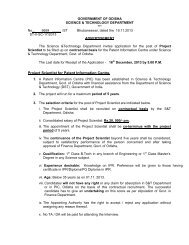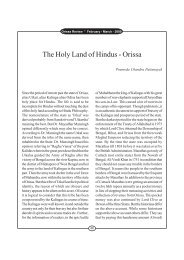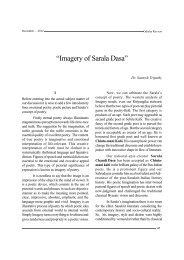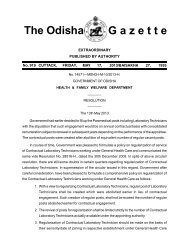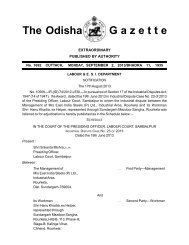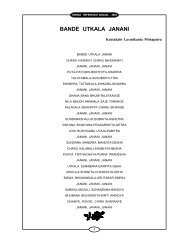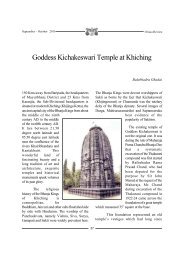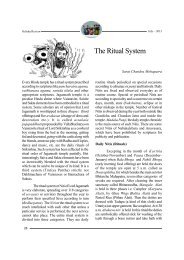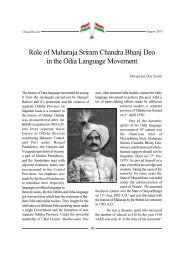Kalinga and Funan : A Study in Ancient Relations
Kalinga and Funan : A Study in Ancient Relations
Kalinga and Funan : A Study in Ancient Relations
You also want an ePaper? Increase the reach of your titles
YUMPU automatically turns print PDFs into web optimized ePapers that Google loves.
November - 2011 Orissa Review<br />
<strong>Kal<strong>in</strong>ga</strong> <strong>and</strong> <strong>Funan</strong> : A <strong>Study</strong> <strong>in</strong> <strong>Ancient</strong> <strong>Relations</strong><br />
<strong>Kal<strong>in</strong>ga</strong> had maritime relationship with ancient<br />
<strong>Funan</strong> (Kambuja or modern Cambodia). The<br />
k<strong>in</strong>gdom of <strong>Funan</strong> roughly corresponds to<br />
Cambodia proper <strong>and</strong> a part of Coch<strong>in</strong>-Ch<strong>in</strong>a<br />
<strong>and</strong> comprised the lower valley of the Mekong. 1<br />
It was an oldest Indianised state of Indo-Ch<strong>in</strong>ese<br />
pen<strong>in</strong>sula. The capital of this k<strong>in</strong>gdom, accord<strong>in</strong>g<br />
to some Ch<strong>in</strong>ese texts, was 500 li (200 km) from<br />
the sea. The materials for writ<strong>in</strong>g the history of<br />
<strong>Funan</strong> of the earlier period are obta<strong>in</strong>ed from the<br />
Ch<strong>in</strong>ese sources, while for the period between c.<br />
650 to c. 800 CE are gleaned from a large number<br />
of <strong>in</strong>scriptions found there. 2 <strong>Funan</strong> is a name<br />
derived from the Ch<strong>in</strong>ese term Phnom mean<strong>in</strong>g<br />
mounta<strong>in</strong>. 3 The natives of <strong>Funan</strong> or Cambodia,<br />
called Khmers, believed that an Indian rishi or<br />
sage was their ancestor. 4 The discovery of Indian<br />
<strong>and</strong> Dongson style objects suggest that there was<br />
very early Indian contact with <strong>Funan</strong>. It is generally<br />
believed that the civilization <strong>in</strong> <strong>Funan</strong> began with<br />
the arrival of Indian traders 5 followed by<br />
missionaries. <strong>Funan</strong> was rich <strong>in</strong> all that Indian<br />
merchants were look<strong>in</strong>g for <strong>and</strong>, <strong>in</strong> addition, was<br />
an ideal half-way house on the sea journey to<br />
Ch<strong>in</strong>a. 6 In ancient times there was tremendous<br />
<strong>in</strong>fluence of Indian culture <strong>and</strong> civilization over<br />
those of <strong>Funan</strong> or Cambodia. In the word of<br />
Ramranjan Das 7 who has done extensive research<br />
on the ancient relation between India <strong>and</strong><br />
33<br />
Dr. Benudhar Patra<br />
Cambodia “Cambodia presents a conspicuous<br />
example of the penetrative power of Indian<br />
civilization. The local people, the Khmers, were<br />
at one time thoroughly H<strong>in</strong>duised. They had<br />
adopted the H<strong>in</strong>du system of adm<strong>in</strong>istration <strong>and</strong><br />
their political ideas were based on the study of<br />
Sanskrit books on political science like Kautilya’s<br />
Arthasastra. In religion they were thoroughly<br />
Indian. The Brahmanical div<strong>in</strong>ities ga<strong>in</strong>ed a special<br />
favour. Saivisim was the dom<strong>in</strong>ant religion.<br />
Vaishnavism was also popular as also Buddhism<br />
though <strong>in</strong> a lesser degree. Sanskrit literature, both<br />
sacred <strong>and</strong> secular, was widely studied. Numerous<br />
Sanskrit <strong>in</strong>scriptions have been found, show<strong>in</strong>g<br />
that their authors had thorough knowledge of the<br />
most developed rules of Sanskrit rhetoric <strong>and</strong><br />
prosody. Numerous asramas were established<br />
after the H<strong>in</strong>du model <strong>and</strong> these served as so many<br />
centres for the diffusion of the ethical <strong>and</strong> spiritual<br />
view of life so characteristic of Indian civilisation.<br />
The art <strong>and</strong> architecture of Cambodia as<br />
manifested <strong>in</strong> temples <strong>and</strong> sculptures of the country<br />
speak of this Indian affiliation <strong>in</strong> a very strik<strong>in</strong>g<br />
manner”. Further, emphasis<strong>in</strong>g the <strong>in</strong>fluence of<br />
Indian art on Cambodia he says, the <strong>in</strong>spiration<br />
of Cambodian art <strong>and</strong> architecture was drawn<br />
from religious belief. Whatever cult or religious<br />
practice, <strong>in</strong> whatever form was prevalent at<br />
different times <strong>in</strong> India, reached Cambodia at
Orissa Review<br />
different epochs <strong>and</strong> found expression of its<br />
particular form <strong>in</strong> Cambodian art <strong>and</strong><br />
architecture 8 .<br />
The orig<strong>in</strong> of the k<strong>in</strong>gdom of <strong>Funan</strong>,<br />
however, is shrouded <strong>in</strong> mystery. Accord<strong>in</strong>g to<br />
K’ang T’ai, a Ch<strong>in</strong>ese envoy who visited <strong>Funan</strong><br />
<strong>in</strong> the middle of the third century CE, the first k<strong>in</strong>g<br />
of <strong>Funan</strong> was a certa<strong>in</strong> Hun-t’ien, that is,<br />
Kaund<strong>in</strong>ya, who came either from India or from<br />
the Malay Pen<strong>in</strong>sula or the southern isl<strong>and</strong>s. 9 This<br />
Ch<strong>in</strong>ese version of the dynastic orig<strong>in</strong> of <strong>Funan</strong><br />
has been corroborated by a Sanskrit <strong>in</strong>scription<br />
of Champa belong<strong>in</strong>g to the third century CE.<br />
Though scholars agree on the po<strong>in</strong>t that the<br />
k<strong>in</strong>gdom of <strong>Funan</strong> came <strong>in</strong>to existence some time<br />
dur<strong>in</strong>g the first century CE, after union of a Brahm<strong>in</strong><br />
named Kaund<strong>in</strong>ya with the Naga Pr<strong>in</strong>cess<br />
Soma(Lieu-Ye), there is considerable<br />
disagreement on the homel<strong>and</strong> of Kaund<strong>in</strong>ya. This<br />
mystical union which was still commemorated at<br />
the court of Angkor at the end of the thirteenth<br />
century <strong>in</strong> a rite identical with that of the Pallava<br />
k<strong>in</strong>gs of Kanchi made some scholars to believe<br />
that Kaund<strong>in</strong>ya probably belonged to the Pallava<br />
k<strong>in</strong>gdom. 10 On the basis of the Mysore <strong>in</strong>scription<br />
(2 nd century CE) which records the grant of l<strong>and</strong>,<br />
to a Siva shr<strong>in</strong>e of the Brahm<strong>in</strong>s of the Kaund<strong>in</strong>ya<br />
gotra (clan), B.R. Chatterjee po<strong>in</strong>ted out that<br />
Kaund<strong>in</strong>yas might have migrated from Mysore<br />
to Indo-Ch<strong>in</strong>a. 11 H.B. Sarkar 12 , however, has<br />
rejected this view <strong>and</strong> proposed that the migrat<strong>in</strong>g<br />
clan of Kaud<strong>in</strong>yas might have migrated to <strong>Funan</strong><br />
from the Amaravati region of Andhra on the ground<br />
of the discovery of specimens of Amaravati style<br />
of sculpture at Dong Duong which was then under<br />
<strong>Funan</strong>. He argues that the Mysore Kaund<strong>in</strong>yas<br />
were not <strong>in</strong> the picture <strong>in</strong> the first century CE when<br />
<strong>Funan</strong> was founded; hence the Kaund<strong>in</strong>yas of<br />
<strong>Funan</strong> could not have gone from the Mysore<br />
region. On the other h<strong>and</strong>, though many scholars<br />
34<br />
November - 2011<br />
have admitted the important role of <strong>Kal<strong>in</strong>ga</strong> <strong>in</strong><br />
the Indianization of Southeast Asia dur<strong>in</strong>g the early<br />
centuries CE, none of them so far has taken notice<br />
of Kaund<strong>in</strong>ya Brahm<strong>in</strong>s who still cont<strong>in</strong>ue to live<br />
near Mahendra mounta<strong>in</strong> range of Orissa which<br />
is very close to the sea. On the basis of this, it is<br />
presumed that the Kaund<strong>in</strong>ya Brahm<strong>in</strong>s might<br />
have migrated from Mahendra mounta<strong>in</strong> region<br />
of <strong>Kal<strong>in</strong>ga</strong> <strong>and</strong> the port of Palur which was<br />
referred to by Ptolemy, the Greek geographer<br />
dur<strong>in</strong>g the 2 nd century CE as an <strong>in</strong>ternational port<br />
could be the port from where Kaund<strong>in</strong>ya<br />
embarked for <strong>Funan</strong>.<br />
The ma<strong>in</strong> reason for the belief that the<br />
homel<strong>and</strong> of Kaund<strong>in</strong>ya Brahm<strong>in</strong>s of <strong>Funan</strong> could<br />
be Mahendra Parvata of <strong>Kal<strong>in</strong>ga</strong> arises from the<br />
fact that the name of Mahendra Mounta<strong>in</strong> appears<br />
<strong>in</strong> the history of <strong>Funan</strong> on two important<br />
occasions. The History of the Southern Ch’i<br />
states that dur<strong>in</strong>g the reign of Jayavarman (5 th<br />
century CE) ‘the custom of this country [<strong>Funan</strong>]<br />
was to worship the God Mahesvara (Siva)’who<br />
cont<strong>in</strong>ually descends on Mount Mo-tan. 13 Motan<br />
could be another name of Mahendragiri of<br />
Orissa which was also considered as an abode<br />
of Lord Siva <strong>and</strong> early Saivism. 14 It was shortly<br />
before c. 500 CE that the Gangas of <strong>Kal<strong>in</strong>ga</strong>(the<br />
Eastern Gangas) were worshipp<strong>in</strong>g Siva-<br />
Gokarnasvam<strong>in</strong> as the tutelary deity of the family<br />
(ista-devata) on Mahendra Mounta<strong>in</strong> 15 . Even<br />
now there is the shr<strong>in</strong>e of Gokarnesvara on the<br />
top of the hill. Worshipp<strong>in</strong>g of Gokarnasvam<strong>in</strong><br />
(on Mahendra Parvat <strong>in</strong> <strong>Kal<strong>in</strong>ga</strong>) <strong>and</strong><br />
Mahesvara (<strong>in</strong> <strong>Funan</strong>) belonged to the same time.<br />
This led to an important assumption that as <strong>Funan</strong><br />
was Indianised by the traders <strong>and</strong> merchants from<br />
the eastern coast of India, the migrants, with the<br />
passage of time named a local mounta<strong>in</strong> of <strong>Funan</strong><br />
as Mahendraparvata after the Mahendra<br />
Parvata of Orissa which had god<br />
Mahesvara(Gokarnesvara) on it. The imitation <strong>and</strong>
November - 2011 Orissa Review<br />
adoption was obvious on the part of migrant<br />
Indians <strong>in</strong> the process of spread <strong>and</strong> <strong>in</strong>troduction<br />
of Indian culture there as elsewhere. The question<br />
comes why they named a mounta<strong>in</strong> of <strong>Funan</strong> as<br />
Mahendra Parvata <strong>and</strong> not after any other Indian<br />
mounta<strong>in</strong> names which logically implies that<br />
Kaund<strong>in</strong>ya <strong>and</strong> early emigrants most probably<br />
went from <strong>Kal<strong>in</strong>ga</strong> region, especially from the<br />
Mahendraparvata region. This is further<br />
corroborated by Jayavarman II (9 th century CE)<br />
of Cambodia who went to reign at<br />
‘Mahendraparvata” <strong>and</strong> <strong>in</strong>stalled a miraculous<br />
Siva l<strong>in</strong>ga there as devaraja or k<strong>in</strong>g of gods<br />
(which is god Siva or Mahesvara himself <strong>in</strong> c.<br />
802 CE) with the help of a Brahman named<br />
Hiranyadama 16 whom he <strong>in</strong>vited from Janapada<br />
(probably <strong>in</strong> India). Jayavarman II is most often<br />
cited <strong>in</strong> the <strong>in</strong>scription as “the k<strong>in</strong>g who<br />
established his residence on the summit of Mount<br />
Mahendra”. This Mahendraparvata (i.e. Mount<br />
Mahendra) has been <strong>in</strong>dentified with Phnom<br />
Kulen, the s<strong>and</strong>stone plateau that dom<strong>in</strong>ates the<br />
northern part of the Angkor pla<strong>in</strong>. 17 As Jayavarman<br />
II went to Mahendra Parvata to reign <strong>and</strong><br />
established his residence there, it appears that<br />
mount Mahendra which was considered as Kula<br />
Parvata (Phnon Kulen) <strong>and</strong> used as the abode<br />
of devaraja was already there <strong>in</strong> <strong>Funan</strong><br />
(Cambodia) before the reign of Jayavarman II.<br />
So, this could have been the mount Mo-tan of<br />
the Ch<strong>in</strong>ese record of the fifth century CE. This<br />
<strong>in</strong>dicates that the Kaund<strong>in</strong>yas of <strong>Funan</strong> were not<br />
only ardent Saivites but also had <strong>in</strong>timate<br />
association with the Mahendra Parvata of <strong>Kal<strong>in</strong>ga</strong><br />
<strong>and</strong> there was close contact between <strong>Kal<strong>in</strong>ga</strong> on<br />
the eastern sea coast of India <strong>and</strong> <strong>Funan</strong> of Indo-<br />
Ch<strong>in</strong>a.<br />
It is a well known fact that fifth century<br />
CE onwards Saivism became popular both <strong>in</strong><br />
ancient Orissa <strong>and</strong> Cambodia. God Siva was<br />
worshipped <strong>in</strong> <strong>Funan</strong> under different names like<br />
35<br />
Mahesvara <strong>and</strong> Tribhubanesvara. Somasarma, the<br />
brother-<strong>in</strong>-law (of Chenla ruler) Mahendravarman<br />
(c.600-611 CE) <strong>in</strong>stalled a statue of<br />
Tribhubanesvara (Siva) <strong>in</strong> a temple. Dur<strong>in</strong>g the<br />
same time, Sasanka of Karnasuvarna (Gauda or<br />
modern Bengal) had constructed the<br />
Tribhubanesvara Siva temple at Ekamra Kshetra<br />
(modern Bhubaneswar) <strong>in</strong> <strong>Kal<strong>in</strong>ga</strong>. This<br />
contemporary <strong>in</strong>stallation of same god could be<br />
a po<strong>in</strong>ter to the close relationship between Orissa<br />
<strong>and</strong> Cambodia. Dur<strong>in</strong>g the time of Isanavarman I<br />
(c.611-635 CE) footpr<strong>in</strong>ts of Siva were <strong>in</strong>stalled,<br />
which f<strong>in</strong>d a reference <strong>in</strong> the Phnom Bayang<br />
<strong>in</strong>scription of 624 CE 18 . In India, worship of<br />
Siva’s footpr<strong>in</strong>ts is rare except <strong>in</strong> places like<br />
Ranipur-Jharial of Western Orissa 19 .<br />
The Devaraja cult which traces its orig<strong>in</strong><br />
to India was a very popular religious cult <strong>in</strong><br />
Cambodia. Scholars 20 identified devaraja as a<br />
chalanti pratima (movable image) of the god<br />
Siva. The Devaraja cult of Cambodia has much<br />
similarity with that of the early medieval Orissan<br />
Saivite cult. The devaraja, as ‘idol unique’ is only<br />
the central god statue or the l<strong>in</strong>ga <strong>in</strong> the central<br />
sanctuary of the temple. Besides the ma<strong>in</strong> statue<br />
there is a further form of the murti (image) of a<br />
god which still plays an extremely important role<br />
today <strong>in</strong> the H<strong>in</strong>du temples of India. This further<br />
form, found <strong>in</strong> many of the larger temples of India,<br />
is the chalanti pratima, which generally takes<br />
the form of a bronze mobile image of the chief<br />
div<strong>in</strong>ity. These movable god-images are an<br />
important constituent of the cult, especially dur<strong>in</strong>g<br />
the festivals of major temples. At the time of the<br />
festival they are carried through the streets on<br />
temple carts or litters as utsava murti (festival<br />
image) of the god – whose primary image rema<strong>in</strong>s<br />
st<strong>and</strong><strong>in</strong>g <strong>in</strong> the temple. A chalanti pratima is<br />
especially important <strong>in</strong> Saivite temples, <strong>in</strong> which<br />
a l<strong>in</strong>ga is worshipped. In this connection we may<br />
cite an example of the L<strong>in</strong>garaja temple of
Orissa Review<br />
Bhubaneswar <strong>in</strong> Orissa. 21 At the nucleus po<strong>in</strong>t of<br />
the temple st<strong>and</strong>s a svayambhu-l<strong>in</strong>ga, a ‘selfexistent’<br />
manifestation of the god Siva, <strong>in</strong> massive<br />
stone. This ‘self-generated’ image of Siva cannot<br />
be removed from the spot where Siva orig<strong>in</strong>ally<br />
manifested himself. So, dur<strong>in</strong>g the numerous<br />
festivals of Lord L<strong>in</strong>garaja, the function of<br />
‘deputy’ for Siva outside the temple is discharged<br />
by a four-armed bronze sculpture of about 45<br />
cm <strong>in</strong> height, which represents Siva as<br />
Ch<strong>and</strong>rasekhara. 22 Dur<strong>in</strong>g the festivals, this<br />
sculpture is the focus of all those rituals that are<br />
directed to Lord L<strong>in</strong>garaja as “(Siva) L<strong>in</strong>ga which<br />
is the k<strong>in</strong>g”. 23 In an Angkorian <strong>in</strong>scription reference<br />
is made to the worship of devaraja <strong>in</strong> the form<br />
of chalanti pratima. 24 An <strong>in</strong>scription of Kok<br />
Rosei enumerates the endowments made by the<br />
priest Sivacharya, who was presumably the<br />
famous purohita of the devaraja under k<strong>in</strong>gs<br />
Jayavarman V <strong>and</strong> Suryavarman I at the end of<br />
the tenth <strong>and</strong> the beg<strong>in</strong>n<strong>in</strong>g of the eleventh centuries<br />
CE 25 .<br />
However, <strong>in</strong> about the twelfth century<br />
CE, the Saivite ideology had lost its significance<br />
both <strong>in</strong> Cambodia <strong>and</strong> <strong>in</strong> all the states of southern<br />
<strong>and</strong> eastern India <strong>in</strong>clud<strong>in</strong>g <strong>Kal<strong>in</strong>ga</strong>. Saivism as<br />
an ideology of state experienced a crisis. It<br />
happened so perhaps because of the activities of<br />
the Great Vaisnavite reformer Ramanuja. Thus,<br />
at the beg<strong>in</strong>n<strong>in</strong>g of the twelfth century CE, k<strong>in</strong>g<br />
Suryavarman II (c.1113 – 1150 CE) <strong>in</strong> Cambodia<br />
submitted to the allure of Vaisnavism at the same<br />
time as Anantavarman Chodaganga Deva, the<br />
Ganga emperor of Orissa (c. 1112 – 1146 CE),<br />
<strong>in</strong> eastern India. Both gave up the Saivite state<br />
religion of their forefathers <strong>and</strong> built up new<br />
gigantic temples <strong>in</strong> honour of the god Vishnu. So,<br />
on either side of the Bay of Bengal, huge<br />
Vaisnavite temples appeared simultaneously, the<br />
Jagannatha temple at Puri, <strong>in</strong> Orissa, <strong>and</strong> Angkor<br />
Wat <strong>in</strong> Cambodia 26 . In the beg<strong>in</strong>n<strong>in</strong>g years of the<br />
36<br />
November - 2011<br />
sixth century CE, Gunavarman “the moon of the<br />
Kaund<strong>in</strong>ya race” established a sanctuary at Thapmuoi<br />
called Chakratirthasvami (Vishnu temple)<br />
that conta<strong>in</strong>ed the footpr<strong>in</strong>ts of Vishnu 27 . In Orissa,<br />
Puri is known as Chakratirtha <strong>and</strong> Lord<br />
Jagannath is venerated as Chakratirthasvami<br />
(Vishnu).<br />
From the history of <strong>Funan</strong> we also learn<br />
that a second Kaund<strong>in</strong>ya ruled the country <strong>in</strong> the<br />
fourth century CE who enforced H<strong>in</strong>du social <strong>and</strong><br />
religious code with more vigour <strong>and</strong> contributed<br />
greatly for Indianisation of the natives. He changed<br />
all the laws of the country <strong>and</strong> brought them <strong>in</strong><br />
the l<strong>in</strong>e with those prevalent <strong>in</strong> India. Accord<strong>in</strong>g<br />
to H.B. Sarkar 28 this Kaund<strong>in</strong>ya II (an Indian<br />
Brahman) had come to <strong>Funan</strong> from P’an-p’an, a<br />
small state <strong>in</strong> Malay Pen<strong>in</strong>sula which was<br />
dom<strong>in</strong>ated by the Brahm<strong>in</strong>s. These Brahm<strong>in</strong>s <strong>in</strong><br />
the days of yore perhaps went from the coast of<br />
<strong>Kal<strong>in</strong>ga</strong> to the Malaya Pen<strong>in</strong>sula <strong>and</strong> thence to<br />
<strong>Funan</strong> “<strong>in</strong> search of wealth”. To strengthen this<br />
ancient <strong>Funan</strong>-<strong>Kal<strong>in</strong>ga</strong> contact <strong>and</strong> migration of<br />
Kaund<strong>in</strong>ya from <strong>Kal<strong>in</strong>ga</strong>, there is also another<br />
evidence that the river Mekong (Me-khong<br />
accord<strong>in</strong>g to Ptolemy)which flows through the<br />
k<strong>in</strong>gdom of <strong>Funan</strong> was called by the name<br />
‘Mahanadi’, the pr<strong>in</strong>cipal river of Orissa. 29<br />
Mekong , however, was also called Ma-Ganga<br />
(the Mother-Ganga) <strong>in</strong> some places. 30 From this<br />
narration it can be presumed that Mekong played<br />
an important role <strong>in</strong> the history of <strong>Funan</strong><br />
(Kambuja or Cambodia) as Mahanadi <strong>and</strong> Ganga<br />
did <strong>in</strong> the early history <strong>and</strong> civilization of <strong>Kal<strong>in</strong>ga</strong><br />
<strong>and</strong> northern India respectively. Further, the<br />
nam<strong>in</strong>g of such an important river of <strong>Funan</strong> by a<br />
<strong>Kal<strong>in</strong>ga</strong>n name positively <strong>in</strong>dicate emigration of a<br />
large number of <strong>Kal<strong>in</strong>ga</strong> people <strong>in</strong>to that country<br />
<strong>in</strong> ancient days.<br />
The H<strong>in</strong>du K<strong>in</strong>gdom of <strong>Funan</strong> flourished<br />
from the 1 st century CE to the middle of the sixth
November - 2011 Orissa Review<br />
century CE. In the time of <strong>Funan</strong>ese k<strong>in</strong>g Fan<br />
Chan (c.225 to 250 CE) there was a diplomatic<br />
mission from <strong>Funan</strong> to Ch<strong>in</strong>a <strong>and</strong> to the court of<br />
Murunda ruler <strong>in</strong> India. The Murundas were rul<strong>in</strong>g<br />
over the <strong>Kal<strong>in</strong>ga</strong> <strong>and</strong> Magadha regions of India. 31<br />
The History of the Liang Dynasty mentions that<br />
Meou-loun was the title of the k<strong>in</strong>g of the<br />
Murundas <strong>and</strong> the envoy who came from <strong>Funan</strong><br />
to India was Su-Wu. Su-Wu com<strong>in</strong>g by sea<br />
arrived at the port of Tamralipti <strong>and</strong> met the<br />
Murunda k<strong>in</strong>g. The Murundas became prom<strong>in</strong>ent<br />
<strong>in</strong> <strong>Kal<strong>in</strong>ga</strong> <strong>in</strong> the second <strong>and</strong> third centuries CE.<br />
Their rule over <strong>Kal<strong>in</strong>ga</strong> could be also attested<br />
from the discovery of a gold co<strong>in</strong> from<br />
Shishupalagarh on the obverse of which the name<br />
of the k<strong>in</strong>g is read as Dhamadamadhara<br />
(Dharmatamadharasya) who received Su-Wu 32 .<br />
The k<strong>in</strong>g presented Su-Wu with four horses. From<br />
this it appears that <strong>in</strong> those days there was regular<br />
export of horses from the port of Tamralipti to<br />
<strong>Funan</strong> <strong>in</strong> which the <strong>Kal<strong>in</strong>ga</strong>n merchants were also<br />
<strong>in</strong>volved 33 . The religion, art <strong>and</strong> architecture of<br />
<strong>Kal<strong>in</strong>ga</strong> also significantly <strong>in</strong>fluenced that of <strong>Funan</strong>.<br />
Regard<strong>in</strong>g the significance of the art of <strong>Funan</strong>, U.<br />
Thakur 34 says, “Of these H<strong>in</strong>du colonies [like<br />
Java, Champa, Burma, Borneo etc.], the k<strong>in</strong>gdom<br />
of Kambuja occupies the most prom<strong>in</strong>ent <strong>and</strong><br />
exalted position. Apart from the fact that it<br />
constituted the largest k<strong>in</strong>gdom <strong>in</strong> South-East<br />
Asia, it also witnessed the remarkable evolution<br />
<strong>and</strong> growth of art <strong>and</strong> architecture produc<strong>in</strong>g some<br />
of the most notable monuments e.g. Angkor Vat<br />
which still excites the wonder <strong>and</strong> admiration of<br />
the world…In respect of architecture, however,<br />
Kambuja surpasses even the motherl<strong>and</strong>.”<br />
Besides art, the Indian sculptures also <strong>in</strong>fluenced<br />
the sculptural form of Cambodia. R.R. Das 35<br />
remarks, “The H<strong>in</strong>du colonists had however<br />
brought with them not only traditions <strong>and</strong><br />
techniques of developed Indian art, but also<br />
probably actual specimens of Indian sculpture.<br />
37<br />
Some of the earlier sculptures <strong>in</strong> Cambodia <strong>and</strong><br />
other countries such as Siam <strong>and</strong> Malaya<br />
Pen<strong>in</strong>sula bear so strik<strong>in</strong>g resemblance to Indian<br />
prototypes that many scholars have held that they<br />
were either brought from India or made by such<br />
craftsmen who were fresh arrivals from India. For<br />
not only the motifs <strong>and</strong> the general details but even<br />
the very technique was purely Indian, <strong>and</strong> there<br />
was hardly anyth<strong>in</strong>g to dist<strong>in</strong>guish those from<br />
Indian products”. The famous Angkor-Wat of<br />
Cambodia has some aff<strong>in</strong>ities with the sikhara of<br />
the temples of Orissa <strong>and</strong> gopuras of the Tamil<br />
temples. 36 In the Banteay Srei <strong>and</strong> Prah Khan<br />
temples of Cambodia, the mullioned open<strong>in</strong>gs are<br />
very splendid <strong>and</strong> <strong>in</strong> their ‘pattern <strong>and</strong> <strong>in</strong>tention’are<br />
ak<strong>in</strong> to the contemporary temples of<br />
Bhubaneswar <strong>in</strong> Orissa 37 . In Angokorean<br />
sculptures, the round eyebrows <strong>and</strong> deep plump<br />
lips are of Orissan variety 38 . In the open part of<br />
terrace on each side of entrance of Angkor Wat,<br />
small shr<strong>in</strong>es were there, which were similar to<br />
pancharatha (division of shr<strong>in</strong>e tower <strong>in</strong>to five<br />
vertical segments) pattern of Orissan temples 39 .<br />
From the above analysis it is evident that there<br />
was close cultural aff<strong>in</strong>ity between <strong>Kal<strong>in</strong>ga</strong> <strong>and</strong><br />
Cambodia <strong>in</strong> ancient times.<br />
References <strong>and</strong> Notes :<br />
1. R.C.Majumdar, Kambuja-Desa or An <strong>Ancient</strong><br />
H<strong>in</strong>du Colony <strong>in</strong> Cambodia, Madras, 1944, p.25<br />
2. N.Dutt, ‘Presidential Address’, Year Book of the<br />
Asiatic society for 1959, Vol.II, 1960, p.18.<br />
3. Ibid.<br />
4. The legendary account regard<strong>in</strong>g the orig<strong>in</strong> of<br />
ancient <strong>Funan</strong> or Cambodia k<strong>in</strong>gdom narrates: In<br />
the dim past Cambodia was a desert of s<strong>and</strong> <strong>and</strong><br />
rocks. One day Kambu Svayambhuva, the k<strong>in</strong>g of<br />
Aryadesa [India] found himself <strong>in</strong> this dreary<br />
l<strong>and</strong>scape. The death of his wife Mera, whom the<br />
great god Siva himself gave him, made him<br />
disconsolate <strong>and</strong> he left his country ‘<strong>in</strong> order to
Orissa Review<br />
die <strong>in</strong> the wildest desert’ he could f<strong>in</strong>d. Hav<strong>in</strong>g<br />
reached Cambodia he entered <strong>in</strong>to a grotto. To his<br />
horror Kambu found himself <strong>in</strong> the midst of a large<br />
number of huge, many-headed snakes whose<br />
pierc<strong>in</strong>g eyes were turned towards him. Kambu,<br />
however, boldly unsheathed his sword <strong>and</strong><br />
advanced towards the biggest snake. To the utter<br />
amazement of Kambu, one of the snakes spoke <strong>in</strong> a<br />
human voice <strong>and</strong> asked his whereabouts. On<br />
hear<strong>in</strong>g Kambu’s story the serpent said: ‘Your name<br />
is unknown to me, stranger, but you spoke of Siva<br />
who is my k<strong>in</strong>g as I am the k<strong>in</strong>g of the Nagas, the<br />
great snakes. You seem to be courageous too;<br />
therefore abide-with us <strong>in</strong> this l<strong>and</strong> you have<br />
chosen <strong>and</strong> end your grief’. Kambu chose to rema<strong>in</strong><br />
there <strong>and</strong> developed a lik<strong>in</strong>g towards the Nagas<br />
who could take human shape. Several years later,<br />
he married the Naga k<strong>in</strong>g’s daughter. The k<strong>in</strong>g of<br />
the Nagas possessed magic power <strong>and</strong> turned the<br />
arid l<strong>and</strong> <strong>in</strong>to a beautiful country like that of<br />
Aryadesa. Kambu ruled over the l<strong>and</strong> <strong>and</strong> the<br />
k<strong>in</strong>gdom came to be called after him as Kambuja.”<br />
A reference <strong>in</strong> brief to the above-mentioned<br />
mythical legend can be found <strong>in</strong> the Baksei<br />
Camkron <strong>in</strong>scription dated c. 947 CE, where the<br />
Kambuja k<strong>in</strong>g treats himself as the descendant of<br />
the great sage Kambu Svayambhuva, to whom<br />
Hara (Siva) gave as his wife Mera, the most<br />
beautiful among apsaras. Though the authenticity<br />
of this legend is doubtful it traditionally refers to<br />
an epoch of the beg<strong>in</strong>n<strong>in</strong>g of H<strong>in</strong>du colonisation<br />
<strong>in</strong> ancient Cambodia. R.C.Majumdar, H<strong>in</strong>du<br />
Colonies <strong>in</strong> the Far East, Calcutta (Firma KLM<br />
Pvt. Ltd.), 1991, p.183; R.R.Das , Kambuja: A<br />
Blend<strong>in</strong>g of Indian Cultural Heritage, Kolkata<br />
(Education Forum), 2008, p.22; K.M.Srivastava,<br />
‘The H<strong>in</strong>du temples of Cambodia’, <strong>in</strong>: G.C.P<strong>and</strong>e<br />
(ed.) India’s Interaction with Southeast Asia<br />
(History of Science, Philosophy <strong>and</strong> Culture <strong>in</strong><br />
Indian Civilization, Vol.I, Pt.3, New Delhi (Centre<br />
for Studies <strong>in</strong> Civilizations), 206, p.322.<br />
5. D.P.S<strong>in</strong>ghal, India <strong>and</strong> World Civilization, Vol.II,<br />
Calcutta (Rupa & Co.), 1972, p.121.<br />
6. Ibid.<br />
7. R.R.Das,op.cit., pp.12-13.<br />
8. Ibid, pp.58 <strong>and</strong> 135.<br />
38<br />
November - 2011<br />
9. Quoted by G.Coedes, The Indianised States of<br />
South East Asia, Honolulu (University of Hawaii<br />
Press), 1967, p.37.<br />
10. Ibid, p.38.<br />
11. B.R.Chatterjee, Indian Cultural Influences <strong>in</strong><br />
Cambodia, Calcutta, 1965/1964, pp.261-262.<br />
12. H.B.Sarkar, ‘The Homel<strong>and</strong> of Kaund<strong>in</strong>ya of <strong>Funan</strong><br />
<strong>and</strong> Tradition about his Marriage’, Journal of<br />
Institute of Asian Studies, Madras, 1934, p.25.<br />
H.B.Sarkar, Trade <strong>and</strong> Commercial Activities of<br />
South India <strong>in</strong> the Malayo-Indonesian World,<br />
Calcutta (Firma KLM Pvt. Ltd.), 1986, pp.48-49.<br />
13. Quoted by G.Coedes, op.cit, p.61.<br />
14. P.P.Mishra, Cultural Rapprochement between<br />
India <strong>and</strong> South East Asia, New Delhi (National<br />
Book Organisation), 2005, p114.<br />
15. H. Kulke, ‘Royal Temple Policy <strong>and</strong> Structure of<br />
Medieval H<strong>in</strong>du K<strong>in</strong>gdoms’, <strong>in</strong>: Anncharlott<br />
Eschmann et al, eds., The Cult of Jagannath <strong>and</strong><br />
the Regional Tradition of Orissa, New Delhi<br />
(Manohar Publishers), 2005, p.130; N.K.Sahu, Utkal<br />
University History of Orissa, Vol.I, Bhubaneswar<br />
(Utkal University), 1964, pp.92-93; B.K.Rath,’ The<br />
History of Mount Mahendra’, Orissa Historical<br />
Research Journal(hereafter OHRJ), Vol. XXII, No.<br />
3 & 4 (1977), p.89.<br />
16. G.Coedes, op.cit, p.99.<br />
17. Ibid, p.100.<br />
18. D.Daweewarn, Brahmanism <strong>in</strong> Southeast Asia,<br />
New Delhi, 1992, p. 25.<br />
19. P.P.Mishra,op.cit., p115.<br />
20. H.Kulke, K<strong>in</strong>gs <strong>and</strong> Cults (State Formation <strong>and</strong><br />
Legitimation <strong>in</strong> India <strong>and</strong> Southeast Asia, New<br />
Delhi (Manohar Publishers), 1993 <strong>and</strong> 2001<br />
(Repr<strong>in</strong>ted), pp355 ff.<br />
21. K.C.Panigrahi, Archaeological Rema<strong>in</strong>s at<br />
Bhubaneswar, Calcutta (Orient Longmans) 1961;<br />
Cuttack (Kitab Mahal), 1981, pp. 164-166; The<br />
L<strong>in</strong>garaj temple is one of the largest Siva temples<br />
<strong>in</strong> eastern India. It is a contemporary monument of<br />
the largest temple mounta<strong>in</strong> of Angkor, the<br />
Baphuon, which was built at the beg<strong>in</strong>n<strong>in</strong>g of the<br />
second half of the eleventh century.
November - 2011 Orissa Review<br />
22. R.L.Mitra, The Antiquities of Orissa, Vol.II, Calcutta<br />
(Indian Studies: Past <strong>and</strong> Present), 1963 pp.133 ff.<br />
23. H.Kulke, K<strong>in</strong>gs <strong>and</strong> Cults, p.358. Accord<strong>in</strong>g to<br />
Herman Kulke, the names L<strong>in</strong>garaj <strong>and</strong> Devaraj are<br />
constructed <strong>in</strong> parallel ways. He says if we relate<br />
l<strong>in</strong>ga to Siva=Deva, then the name L<strong>in</strong>garaja comes<br />
very close to the name devaraja <strong>in</strong> mean<strong>in</strong>g as<br />
well.<br />
24. Ibid, p.359.<br />
25. Ibid.<br />
26. Ibid, p.375.<br />
27. D.G.E.Hall, A History of South-East Asia, New York<br />
(Macmillan), 1970, p.32.<br />
28. H.B.Sarkar, Cultural <strong>Relations</strong> between India <strong>and</strong><br />
South East Asian Countries, New Delhi (Indian<br />
Council for Cultural <strong>Relations</strong> <strong>and</strong> Motilal<br />
Banarsidass), 1985, p.153.<br />
29. Researches on Ptolemy’s Geography of Eastern<br />
Asia (Further India <strong>and</strong> Indo-Malay<br />
Archipelago), G.E.Ger<strong>in</strong>i, London (Asiatic Society),<br />
1909; New Delhi (Oriental Books Repr<strong>in</strong>t<br />
Corporation), 1974, p.136.<br />
30. R.C.Majumdar, H<strong>in</strong>du Colonies <strong>in</strong> the Far East,<br />
Calcutta (Firma KLM Pvt.Ltd), 1991, p.175.<br />
31. N.K.Sahu, op.cit, p.418 ff.<br />
32. B.B.Lal, ‘Sisupalagarh’, OHRJ, Vol.XV (1967), pp.51-<br />
55; B.B.Lal, ‘Sisupalgarh 1948: an Early Historical<br />
39<br />
Fort <strong>in</strong> Eastern India’, <strong>Ancient</strong> India (Bullet<strong>in</strong> of<br />
the Archaeological Survey of India), No.5 (1949),<br />
pp.100-101.<br />
33. P.P. Mishra, op.cit, pp. 114.<br />
34. U.Thakur, ‘Kaund<strong>in</strong>ya: The Founder of Indian<br />
K<strong>in</strong>gdom <strong>in</strong> <strong>Funan</strong> <strong>and</strong> Kambuja’, JBRS, Vol. LIV,<br />
Pts. I-IV, (1968), pp.68-69; U.Thakur, Some Aspects<br />
of Asian History <strong>and</strong> Culture, New Delhi (Abh<strong>in</strong>av<br />
Publications), 1986, pp.15-16.<br />
35. R.R.Das, Art Tradition of Cambodia, Calcutta<br />
(Firma KLM Pvt. Ltd.), 1974, pp.70-71.<br />
36. R.Grousset, The Civilizations of the East: India,<br />
Delhi (Munshiram Manoharlal), 1969, pp.315-316.<br />
37. P.Brown, India Architecture, (Buddhist <strong>and</strong> H<strong>in</strong>du<br />
Periods), Bombay (Taraporevala Sons <strong>and</strong> Co.<br />
Pvt.Ltd.), 1971, p.184.<br />
38. H.G.Wells, The Mounta<strong>in</strong> of God: A <strong>Study</strong> <strong>in</strong> Early<br />
Religion <strong>and</strong> K<strong>in</strong>gship, London, 1953, pp. 182 ff.<br />
39. P.P.Mishra, op.cit, p.116.<br />
All art is but imitation of nature. – Seneca<br />
Dr. Benudhar Patra, P.G. Dept. of History, Post Graduate<br />
Govt. College, Sector-11, Ch<strong>and</strong>igarh (UT)-160011,<br />
India. Email: dr_benudharpatra@yahoo.co.<strong>in</strong>.



